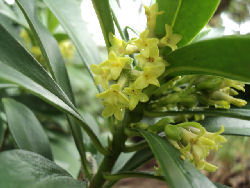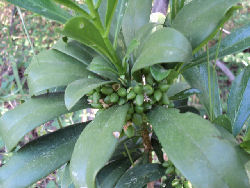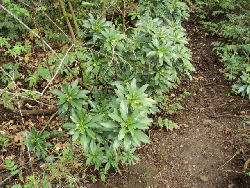|
|
|
|
|
|
| Practical ecological knowledge for the temperate reader. |
Spurge-laurel - Daphne laureola
Family: Thymelaeaceae (Mezereum family) [E-flora]
- Deadly, Externally; Various uses, most notably syphilis
Description
General Bushy.[IFBC] [E-flora] "growing to 1 m (3ft 3in)." [PFAF] "Plants can live
longer than 40 years....Branches readily sprout from the base of older stems, often
growing horizontally for a short distance before turning upwards." [NRN]
Lifecycle Evergreen.[PFAF] deciduous or evergreen. [RHS]
Flowers greenish-yellow flowers. [RHS] "Inflorescence of axillary, nearly unstalked clusters".[IFBC] [E-flora] "The flowers are hermaphrodite...and are pollinated by Bees, lepidoptera." [PFAF]
Fruits Drupes, egg-shaped.[IFBC] [E-flora] black berries [NRN]
Leaves glossy dark green [RHS] "Alternate, oval to oblanceolate..."[IFBC] [E-flora]
Properties Very fragrant flowers. [RHS]
Habitat "Mesic forests and waste areas".[IFBC][E-flora] "Woods, mainly on calcareous soils, where it is widespread and rather common[17]." [PFAF] "moist areas of our Douglas fir/ arbutus and Garry oak ecosystems, replacing native vegetation and forming a dense canopy blocking out light to the ground." [mgabc]
Range "infrequent on S Vancouver Island, the Gulf Islands and adjacent mainland; introduced from Eurasia."[IFBC][E-flora] "Western and southern Europe, from Britain and Belgium to Spain and Macedonia, N. Africa, W. Asia." [PFAF] Introduced from Mediterranean Eurasia.[NRN]
Fully Naturalized in New Zealand [NewZeaNatural]
"generally found in the understory of coniferous and mixed montane forests in the Mediterranean area." [Alonso, 2009]
Status Exotic. [E-flora]
Notes "This species is listed by the Greater Vancouver Invasive Plant Council of the twelve most problematic species in the Vancouver region." [E-flora]
Hazards
- Plant: "All parts of the plant are poisonous[200]. Skin contact with the sap can cause dermatitis in some people[65, 200]." [PFAF] "The bark, sap and berries of all daphnes are toxic to humans and small animals, and the sap is a skin irritant. [mgabc]
- Daphne Sp; "Chewing the bark, flowers, or fruits causes painful blistering of the lips, mouth, and throat, with salivation, thirst, and inability to eat or drink, followed by swelling of the eyelids and nostrils, intense burning and ulceration of the digestive tract, vomiting, bloody diarrhea, weakness, headaches, and in severe cases, delirium, convulsions, coma, and death." [CPPlantMush]` "All parts of all species of daphnes are poisonous, but especially the attractive fruit....Rubbing the leaves against the skin may produce blisters and irritation." [KYP James]
- "Daphne, Thymelaea (Thymeleaceae) species contain highly toxic diterpenes." [Mathe MAPW] Daphne sp. diterpenes are Gastrointestinal irritants. [DP1]
- "Daphne mezereum L. and other species of the thymelaeaceous genus Daphne have been recognized since at least the 11th century as virulent poisons, and more recent cases have confirmed the toxicity, doses of a few berries or a few grams of bark being reported fatal to man, dog, or horse." [Stout et al.,1970]
- The berries are toxic. "Paleness; Pupil dilation; Mouth and lips swilling; Diarrhea; Convulsion; Pulmonary disorder; Difficulty of deglutition; Death".[M. Bnouham et al.] "In addition to the irritant effects on the digestive tract, seizures, tremors and deaths have been reported in children who ate the fruits [1,3]." "The bitter taste of the fruits generally limits intake and therefore the severity of poisoning." "Intense reddening and swelling of the oral mucous membranes, excessive salivation, blistering of the tongue and lips, and vomiting are common effects of Daphne poisoning. Diarrhea with blood may occur if sufficient plant material was swallowed. Treatment usually requires activated charcoal orally, along with fluid therapy where diarrhea leads to dehydration."[DP2]
Other Uses
- "The leaves were also put under the pillow to induce dreams (Lea)." [DPL Watts]
Medicinal Uses
- Bark:
- "Germicidal, a diuretic, expectorant and laxative. For rheumatism and skin ailments". [Jaric et al.]
- Cancer: "The bark...was used in the treatment of cancer (Grigson. 1955), though this was only a cottage remedy, and there seems no record of how it was done, nor whether it was really cancer (and not canker) that was being treated." [DPL Watts]
- Skin afflictions: Syphilis and rheumatic conditions. Used externally, it should be steeped in hot vinegar and kept in contact with the skin by a bandage. Doubtful results and rarely prescribed on it's own. Dosage: 10-12 grains in infusion, 2-3 times/daily. [POI]
- Leaves: "The leaves have been used as an emmenagogue, though they can cause purging and vomiting[4]." [PFAF]
Ethnobotany
Medicinal Use
- "...said to furnish a portion of mezereum of commerce, and is recognized by the U. S, Pharmaicopoeia, but its product is inferior in acrimony, and consequently in medicinal activity." [Remington USD20]
- It was mixed with mistletoe and given for epilepsy. [MPFT]
- valued as "...a horse medicine and as a cure for venereal disease and both benign and malignant cancers." [MPFT]
Pharmacology
"Other genera in the family Thymelaeaceae
(Daphne, Gnidia, etc.) have pro-inflammatory, cocarcinogenic diterpenes" [Alkaloids,chem&Bioperspect8]
- Cancer [Hartwell]; [DukePhyt]
- laxative. [MPFT][M. Bnouham et al.]
- Poison [Steinmetz]; [DukePhyt]
- Purgative [FontQuer, Steinmetz]; [DukePhyt] a brisk and rather severe purgative. [MPFT] Strong purgative [M. Bnouham et al.]
- Tumor(Spleen) [Hartwell][DukePhyt]
Dried Bark:
- Sialagogue, [Sayre]
- stimulant [Sayre][POI]
- diaphoretic [POI]
- diuretic [POI]
- alterative.[Sayre]
- Externally vesicant. Applied as an ointment or a poultice.[Sayre] As well as rubefacient. [POI]
Phytochemistry
Daphne Sp.; "...the genus Daphne contains many classes of secondary metabolites,
some of which are dominated coumarins,
flavonoids, lignans, and steroids". [Sovrlic et al.]
"The plant contains various toxic compounds and these are currently being investigated (1995) for anti-leukaemia effects[238]." [PFAF]
"The bark contains a crystalline glucoside, daphnin, which is not the active principle, however, the medical
virtues depending upon an acrid resin termed mezerein." [Sayre] Daphne mezereum; "Daphnetoxin and mezerein are diterpene alcohols with a daphnane skeleton. Mezerein has cocarcinogenic activity as does the chemically related phorbol esters found in many toxic members of the spurge family (Euphorbiaceae)." [CPPIS]
|
Total polyphenols (% Dry Weight)
- Leaves; 1.42±0.20 [Grubeši? et al.]
- Stems; 2.47±0.25 [Grubeši? et al.]
- Roots; 2.71±0.11 [Grubeši? et al.]
|
Tannins (% DW)
- Leaves; 0.36±0.12 [Grubeši? et al.]
- Stems; 0.97±0.17 [Grubeši? et al.]
- Roots ; 1.14±0.04 [Grubeši? et al.]
|
Total flavonoids (% DW)
- Leaves; 0.51±0. [Grubeši? et al.]
- Stems; 0.20±0.07 [Grubeši? et al.]
- Roots ; 0.07±0.03 [Grubeši? et al.]
|
|
Total phenolic acids (% DW)
- Leaves; 0.14 ± 0.01 [Grubeši? et al.]
- Stems; 0.12 ± 0.01 [Grubeši? et al.]
- Roots ; 0.14 ± 0.02 [Grubeši? et al.]
|
Radical Scavenging Activity EC50(mg/mL)
- Leaves; 4363.37 ± 159.35 [Grubeši? et al.]
- Stems; 799.06 ± 126.42 [Grubeši? et al.]
- Roots ; 1285.36 ± 30.04 [Grubeši? et al.]
| Antioxidant EC50(mg/mL)
- Leaves; 308.56 ± 8.23 [Grubeši? et al.]
- Stems; 404.61 ± 15.14 [Grubeši? et al.]
- Roots ; 328.74 ± 2.59 [Grubeši? et al.]
|
|
* "The term half maximal effective concentration (EC50) refers to the concentration of a drug, antibody or toxicant which induces a response halfway between the baseline and maximum after a specified exposure time.[1] It is commonly used as a measure of drug's potency." [Wiki]
|
Coumarins
"...we identified three different glycosides of 7-methoxycoumarin in leaves of this species. Total coumarin concentration averaged between 60 and 120 mg/g dry weight for mature summer leaves of D. laureola growing at six different populations. As predicted by optimal theory, females tended to have a higher concentration of coumarins than hermaphrodites, thus upholding the idea that male reproductive function is costly for hermaphrodites." [Alonso et al.] Three glycosides of 7-methoxy-coumarin have recently been isolated from D. laureola leaves (Alonso et al., 2005). [Alonso, 2009]
Daphne mezereum; "The bark of these daphne plants contains a coumarin glycoside that has the aglycone dihydroxycoumarin (Fuller and McClintock 1986)."[CPPIS]
Diterpenes
"Polyfimctional diterpene esters of the tigliane,
ingenane, and daphnene types are responsible for the acrid properties [of Eupborbiaceae and Thymelaeaeae]." [Seiger PSM]
"The fruit and bark of Daphne species contain daphnetoxin
(19). The seeds contain mezerein (21). Both of these compounds can produce irritant dermatitis in humans, and mezerein (21) possesses cocarcinogenic activity as well (Alcaraz
and Rios, 1991). Odoracin (22), a structurally similar diterpene from Daphne, possesses nematicidal activity in tests
against the nematode, Aphelenchoides beseyi. At 5 ppm, this
diterpene is 100% nematicidal (Mabry and Gill, 1979)." [Seiger PSM]
"The diterpenes of yuan-hua, Daphne genkwa, have been reported to be abortifacient (Bingel and Fong, 1988). Four active
compounds have been isolated: yuanhuacine (23), yuanhuadine (24), yuanhuaf'me (25), and yuanhuatine (26). Yuanhua·
dine is administered intra-amnionically and yuanhuacine
either intra- or extra-amniotically to induce second-trimester
abortion (Bingel and Fong, 1988)." [Seiger PSM]
Cultivation
"Prefers a moist soil and a position in semi-shade, growing well in woodlands[11]. Plants are often found growing in dense shade in the wild[245]. A good sandy loam suits most members of this genus[11]. Flowers are produced towards the ends of the previous year's growth[11]. They are sweetly scented[245]. Plants are resentful of root disturbance and should be planted into their permanent positions as soon as possible[188]." [PFAF]
Caution should be used with daphne removal because burning, brush sawing, or chipping releases noxious chemicals into the air. These chemicals also prevent browsers from eating Daphne. [NRN]
"...in drier forests, such as those in the rain shadow of
the Olympic Mountains, invasive species such as
holly (Ilex aquifolium), ivy - Hedera helix and H.
hibernica...,
and spurge laurel (Daphne laureola) have little
difficulty establishing a toe-hold even in undisturbed forests. In disturbed areas diverse invasive
species can establish and create restoration challenges." [Apostol RPNW]
Herbivory
Considered a deer resistant plant [1]
Foliage-feeding lepidopteran larvae were the most
frequent herbivores on D. laureola. Mammalian herbivores do not browse on D. laureola plants, probably
because of the presence of a variety of toxic and repellent substances in the foliage (Hegnauer 1972)." [Alonso,1996]
"Herbivory by noctuid moth larvae (Lepidoptera, Noctuidae) on" D. lauereola "was studied under natural conditions in a south-eastern Spanish montane habitat." "Variation among plants in the incidence of noctuid larvae was directly related to the number of leaf whorls, and inversely to the mean basal diameter of stems," "Within plants, larvae preferentially selected leaf whorls having shorter supporting stems and lower branching orders." [Alonso,1996] Population defoliation
levels of D. laureola averaged less than 5% of the leaf area,
and individual defoliation ranged between 0.9 and 12.8% [Alonso, 2009]
"Daphne laureola seems to be a well-defended plant. In southern Spanish populations in which Noctuidae diversity is high (Yela & Herrera, 1993), D. laureola is only consumed by four species and herbivory levels are moderate to low (Alonso & Herrera, 1996, 2003).... the highly polyphagous S. littoralis[(Spodoptera littoralis)] demonstrated rejection of D. laureola leaves at early stages of larval development; the most abundant coumarin in young leaves also efficiently decreased consumption by late instars, thus supporting a defensive role of this compound against generalist herbivorous insects." [Alonso, 2009]
Propagation
"Seed - best sown in a greenhouse as soon as it is ripe with the pot sealed in a polythene bag to hold in the moisture. Remove this bag as soon as germination takes place[164]. The seed usually germinates better if it is harvested 'green' (when it has fully developed but before it dries on the plant) and sown immediately. Germination should normally take place by spring, though it sometimes takes a further year. Stored seed is more problematic. It should be warm stratified for 8 - 12 weeks at 20°c followed by 12 - 14 weeks at 3°c. Germination may still take another 12 months or more at 15°c[164]. Prick out the seedlings into individual pots as soon as they are large enough to handle. Grow the plants on in the greenhouse for their first winter and then plant out in spring after the last expected frosts. Cuttings of half-ripe wood, July/August in a frame." [PFAF]
Daphne Sp.
"The genus Daphne (Thymelaeaceae), including
about 70 species, is distributed in Europe, Asia, North
Africa and Australia. Species Daphne cneorum distributed in West, Central and East Europe, Mediterranean
region, South–West Asia." [Manojlovic et al.]
"Comprising a genus of some 50 or more species, Daphne are native to Europe, North Africa, and subtropical Asia." [DP2]
"Species of the genus Daphne are used in natural
medicine as a diuretic, laxative, an anticoagulant, in the
treatment against skin diseases, toothache, and malaria. Previous studies of individual species of the genus Daphne indicate their potential broad application in
medicine [7–11]." [Manojlovic et al.] "Daphne species...used... also in
traditional medicine as a purgative, anticoagulant
and diuretic." [Sovrlic et al.]
"All the species of Daphne are possessed of active properties, but three
only are official—D. Mesereum, D. Laureola, and D. Gnidium, all of
which are recognized in the United States Pharm., and the last in the
former French Codex, 1884." [Remington USD20]
- Externally applied to ulcers: "The recent bark applied to the skin produces inflammation followed by vesication, and has been popularly used as an epispastic, from time immemorial, in some of the southern countries of Europe. The dried bark, though less active, is possessed of a similar property, and is occasionally employed in France by regular practitioners for the purpose of forming issues. A small square piece, moistened with vinegar, is applied to the skin, and renewed twice a day until a blister is formed, and occasionally afterwards to keep up the discharge. It is slow in its operation, generally requiring from twenty-four to forty-eight hours to vvesicate. The ointment was formerly used for maintaining the discharge from blistered surfaces, and may be applied advantageously to obstinate, ill-conditioned indolent ulcers. It was recognized by the U. S. 1880." [Remington USD20]
References
- [1] - A Gardener’s Guide to Preventing Deer Damage, California Department of Fish and Game’s Wildlife Programs Branch, THE STATE OF CALIFORNIA, Arnold Schwarzenegger, Governor
- [Adams Rheumatics] - Medicinal herbs for the treatment of rheumatic disorders—A survey of European herbals from the 16th and 17th century, Michael Adams, Caroline Berset , Michael Kessler , Matthias Hamburger, Journal of Ethnopharmacology 121 (2009) 343–359
- [Alonso,1996] - Variation in Herbivory within and among Plants of Daphne Laureola (Thymelaeaceae): Correlation with Plant Size and Architecture, Conchita Alonso, Carlos M. Herrera, Sevilla, Spain, Journal of Ecology, Vol. 84, No. 4 (Aug., 1996), pp. 495-502
- [Alonso,2009] - Variability in the behavioural responses of threegeneralist herbivores to the most abundant coumarin in Daphne laureola leaves, Conchita Alonso, Isabel M. García, Nelson Zapata2§ & Ricardo Pérez, Entomologia Experimentalis et Applicata 132: 76–83, 2009
- [Alonso et al.] Gender dimorphism and altitudinal variation of secondary compounds in leaves of the gynodioecious shrub Daphne laureola, Alonso C, Pérez R, Nieto PM, Delgado J., J Chem Ecol. 2005 Jan;31(1):139-50.
- [CPPIS] Daphne mezereum, Canadian Poisonous Plants Information System, http://www.cbif.gc.ca/eng/species-bank/canadian-poisonous-plants-information-system/all-plants-scientific-name/daphne-mezereum/?id=1370403266827, Accessed Oct 25, 2015
- [DukePhyt] Daphne laureola (THYMELAEACEAE), Accessed March 9, 2015, http://www.ars-grin.gov/duke/
- [E-flora] http://linnet.geog.ubc.ca/Atlas/Atlas.aspx?sciname=Daphne Accessed March 9, 2015
- [Grubeši? et al.] - Quantitative analysis of polyphenols and antioxidant activity in four Daphne L. species, Renata Juriši? Grubeši? , Dario Kremer, Marijana Zovko Kon?i?, Jadranka Vukovi? Rodríguez, Marko Randi?, Cent. Eur. J. Biol. • 7(6) • 2012 • 1092-1100
- [Jaric et al.] - An ethnobotanical study on the usage of wild medicinal herbs from Kopaonik Mountain (Central Serbia). Jari? S, Popovi? Z, Macukanovi?-Joci? M, Djurdjevi? L, Mijatovi? M, Karadzi? B, Mitrovi? M, Pavlovi? P., J Ethnopharmacol. 2007 Apr 20;111(1):160-75. Epub 2006 Nov 12.
- [M. Bnouham et al.] - Toxic effects of some medicinal plants used in Moroccan traditional medicine, Mohamed Bnouham, Fatima Zahra Merhfour, Mostafa Elachoui, Abdelkhaleq Legssyer, Hassane Mekhfi, Driss Lamnaouer & Abderrahim Ziyyat, Moroccan J. Biol. 2-3 (2006) 21-30
- [Manojlovic et al.] - HPLC Analysis, antimicrobial and antioxidant activities of Daphne cneorum Manojlovi? Nedeljko T., Maškovi? Pavle Z., Vasiljevi? Perica J., Jeli? Ratomir M., Juskovi? Marina Ž., Sovrli? Miroslav, Mandi? Leka, and Radojkovi? Marija, Hem. ind. 66 (5) 709–716 (2012) http://www.ache.org.rs/HI/ Jari? S, Popovi? Z, Macukanovi?-Joci? M, Djurdjevi? L, Mijatovi? M, Karadzi? B, Mitrovi? M, Pavlovi? P., Journal of Ethnopharmacology 111 (2007) 160–175
- [mgabc] A DANGEROUS GARDEN THUG EXPOSED: Daphne laureola, Master gardeners Association of B.C., http://www.mgabc.org/content/dangerous-garden-thug-exposed-daphne-laureola, Accessed Oct 25, 2015
- [NRN] Daphne Laureola, Natural Resource Notes, Information from the Department of National Defense - Canadian Forest Service Natural Resource Program, No 1., 2003
- [PFAF] http://www.pfaf.org/user/Plant.aspx?LatinName=Daphne+laureola Accessed March 9, 2015
- [RHS] Daphne laureola, View, The Royal Horticultural Society 2015
- [Seiger PSM] - Plant Secondary Metabolism, David S. Seiger, 1998 Springer Science& Business Media
- Daphne Sp. are collectively referred to but specifically mentioned in the index, in relation to this information, is D. genkwa, D. mezereum, and D. odora.
- [Sovrlic et al.] Phytochemical, Antioxidant and Antimicrobial Profiles of Extracts of Daphne alpina (Thymelaeaceae) L Leaf and Twig from Mt Kopaonik (Serbia), Sovrlic Miroslav M Vasiljevic Perica J Juskovic Marina Z Maskovic Pavle Z Manojlovic Nedeljko T,Tropical Journal of Pharmaceutical Research July 2015; 14 (7): 1239-1248, http://dx.doi.org/10.4314/tjpr.v14i7.17
- [Stout et al.,1970] - The Isolation and Structure of Daphnetoxin, the Poisonous Principle of Daphne Species, George H. Stout, Wayne G. Balkenhol Mitchell Poling, Gary L. Hickernell, Journal of the American Chemical Society 92:4 February 25, 1970
- [Wiki] - EC50 - Wikipedia.org, Accessed Feb 2, 2016. https://en.wikipedia.org/wiki/EC50
- 1 - Introducing dose response curves, Graphpad Software
Page last modified on Friday, December 25, 2020 5:10 AM




